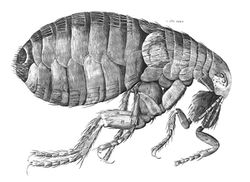Flea Structure
| This article is still under construction. |
Overview
Fleas make up the taxonomical order Siphonaptera containing approximately 2500 species all of which are very similar in morphology. All are obligate blood feeders, which is apparent in the morphology of the mouthparts. Though they are all small, between 1 and 6mm, there is considerable sexual dimporphism, the females being larger than the males. The body of the flea is laterally flattened to allow for easy movement between hair and feathers and also to improve jumping.
Head
The head holds the mouthparts, eyes and antennae of the flea. The eyes of the flea, when present, are little more than photosensitive spots either side of the head. As an adaptation to allow easy movement between the hairs or feathers of the host the fleas antennae are short and sunken into the head so as not to protrude.
Mouthparts
The mouthparts of the flea are adapted to piercing and sucking to enable feeding on the blood of the host. The most prominent feature are the well developed maxillary palps.
Legs
Fleas are 6 legged, the two front pairs are considerably shorter than the most caudal pair. They are made up of 5 parts; coxa, femur, tibia, tarsus and claw from proximal to distal. The increased length of the most caudal legs is an adaptation to increase the distance that the flea can jump. This allows the flea to easily move between hosts, one of them major reasons for their veterinary importance.
The terms ctenidia and combs can be used interchangably for spines on the head/thorax. Spines on the cheeks are referred to as genal and spines on the thorax are called pronotal combs. The presence and location of the chitinous spines are important in differentiating between the different flea species. The chitinous anal struts are also used for identification and help the flea larvae with vigorous motility.

